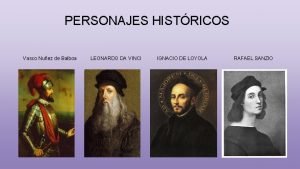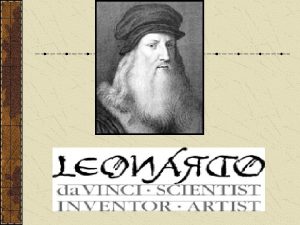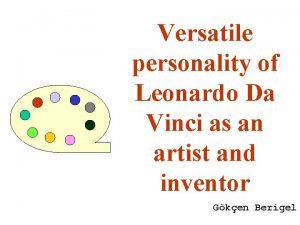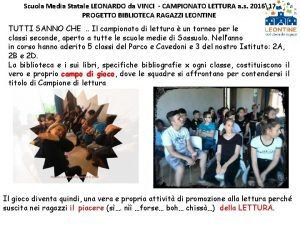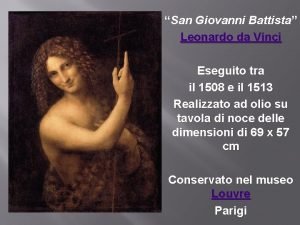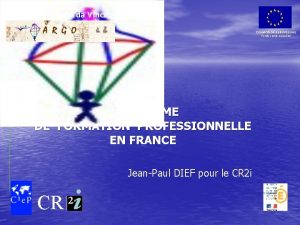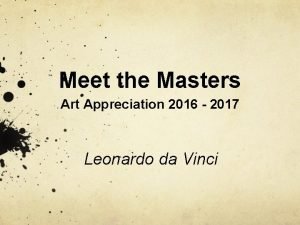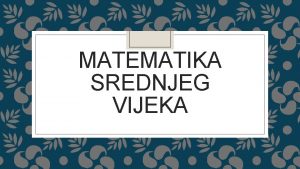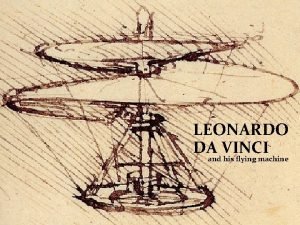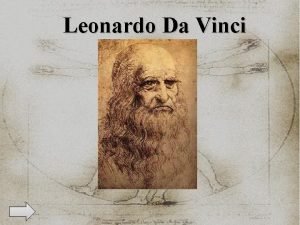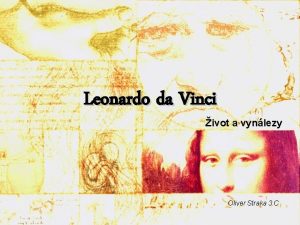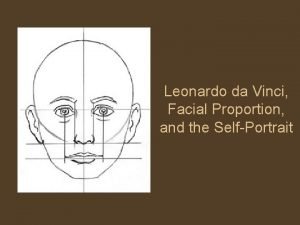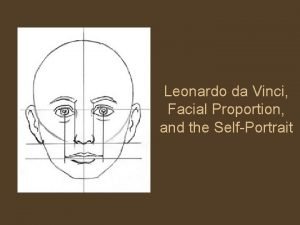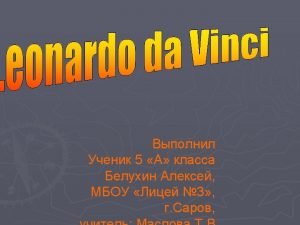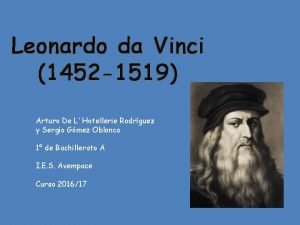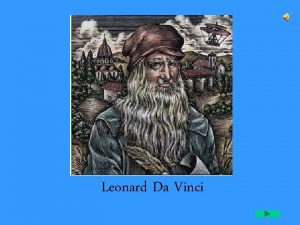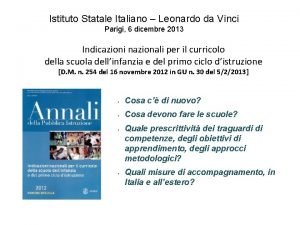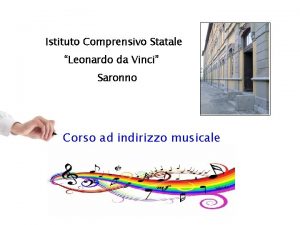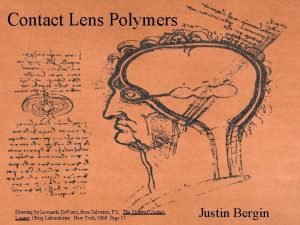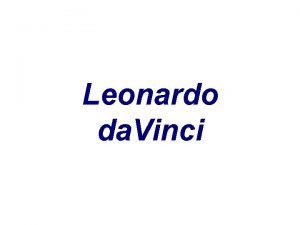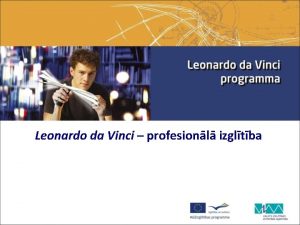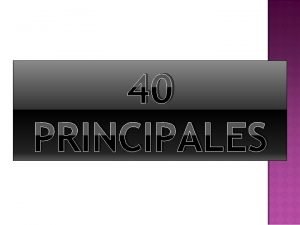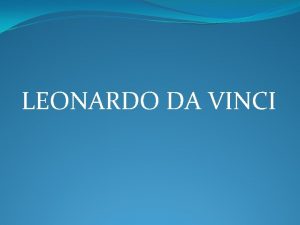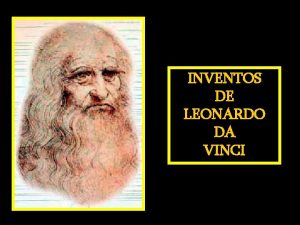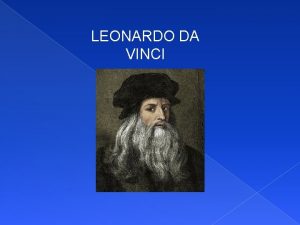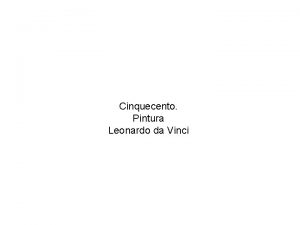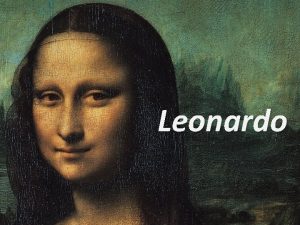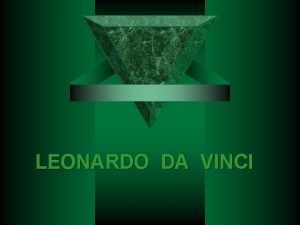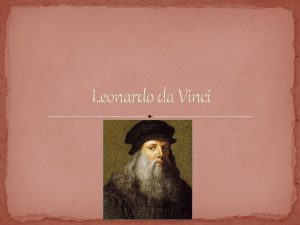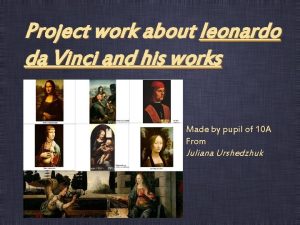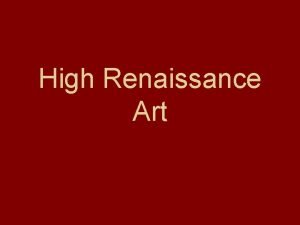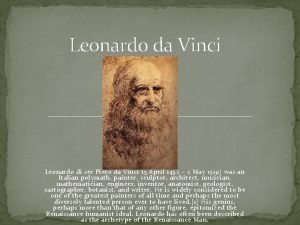Leonardo Da Vinci LEONARDO DA VINCI and his





















- Slides: 21

Leonardo Da Vinci LEONARDO DA VINCI and his flying machine Organization Name

Leonardo da Vinci � Lived from 1452 -1519 � Leonardo was born in a farmhouse in Italy near Vinci � His father and grandparents raised him � When he was 14 years old he studied under a well known artist of the time, Andrea del Verrocchio. Eventually, da Vinci became so good at painting that his teacher felt he could never paint as well as da Vinci. Learning never exhausts the mind. -- Leonardo da Vinci

Growing as an Artist � At 20 he was considered a master artist student � Leonardo da Vinci created some of the most famous pieces of art in the world � And at an early age his interests spanned from art, science, architecture and inventing. Today, the term “Renaissance Man” is used to describe a person with many abilities and interests, like Leonardo da Vinci. “Lady with an Ermine” - 1483 -1490

High Renaissance � Pioneering use of chiaroscuro —a stark contrast between darkness and light that gave a three-dimensionality to his figures—and sfumato—a technique that makes soft borders around his figures which makes them look soft and smoky. � As a perfectionist, da Vinci frequently didn’t complete paintings, or would paint over an image until he got it where he was okay with it. “The Immortal Mortal” - 1412 -1419

One of the Most Famous Paintings � The "Mona Lisa" is a picture of Lisa del Giocondo, the wife of a wealthy Florentine silk merchant. � The painting’s original Italian name—“La Gioconda”—supports theory, but it’s far from certain. Some art historians believe the merchant commissioned the portrait to celebrate the pending birth of the couple’s next child, which means the subject could have been pregnant at the time of the painting. “Mona Lisa”- 1503 -1519

Following the Artist Path “The Last Supper”- 1498 � He painted for popes and kings � Da Vinci viewed science and art as overlapping subjects rather than separate ones. He believed studying science made him a better artist. “The noblest pleasure is the joy of understanding. ” -- Leonardo da Vinci

The Beauty in Sketches � Studied the human body to more accurately depict those gestures and movements, da Vinci began to seriously study anatomy and dissect human and animal bodies during the 1480 s.

The Beauty in Sketches � His drawings of the heart and vascular system, organs and other bone and muscular structures are some of the first on human record. � Da Vinci frequently wrote backwards. It took a long time for researchers to realize that the words could be read when viewing them in a mirror.

Thinking Outside the Box � He drew ideas for musical instruments, war machines, calculators, boats, etc. Many of these plans were limited by the level of technology at the time. � Flight was of particular interest to da Vinci. He studied the flight of birds and created plans for flying machines that resemble hang gliders and helicopters. � Many of Leonardo da Vinci’s machines have since been built and tested, to varying levels of success.

Da Vinci’s Interest in Flying Click on video to play

Ideas �Using his inventive mind, da Vinci sketched an armored tank propelled by two men cranking a shaft and even an enormous crossbow that required a small army of men to operate.

A True Renaissance Man �Although da Vinci is known for his artistic abilities, fewer than two-dozen paintings made by him exist. One reason is that his interests were so varied that he wasn’t a prolific painter. �For centuries afterward, however, thousands of pages from his private journals with notes, drawings, observations and scientific theories have surfaced and provided a fuller measure of a true “Renaissance man. ”

Todays Project Materials: • • Paper Pencil Eraser Brown Colored Pencil Glue Stick Tissue Paper Hand Wipes � Name on your paper �Expect a lot of erasing! � Be Patient � You are going to get sticky � You’re going to create your own masterpiece

Steps 1, 2, 3 �Step One �Put Your Name on Your Paper! �Step Two �Step Three

Steps 4, 5, 6 �Step Four �Step Five �Step Six

Steps 7, 8, 9 �Step Seven �Step Eight �Step Nine

Step 10 – Colored Pencil � Use the colored pencil to color in the wood. Color light in certain areas and dark in others. Use your regular pencil too for the gray.

Step 11 – Gluing � Add glue to a small section of the helicopter blade. � Add little bits of tissue over the glue. They can be scrunched to add texture or flat. Use the end of the pencil to push it down.

Step 11 – Gluing �Use different colors of tissue to the sections. �Be creative to make it your own.

Great Job! �I can’t wait to see your results. �See you next time!

References � http: //www. sciencekids. co. nz/sciencefacts/scienti sts/leonardodavinci. html � http: //www. history. com/topics/leonardo-da-vinci � https: //en. wikipedia. org/wiki/Vitruvian_Man � http: //www. ibiblio. org/wm/paint/auth/vinci/ � http: //www. biography. com/people/leonardo-davinci-40396#humble-beginnings � http: //makingartfun. com/htm/f-maf-artlibrary/leonardo-da-vinci-biography. htm
 Leonardo da vinci was born on april 15
Leonardo da vinci was born on april 15 Vasco da vinci
Vasco da vinci April 15 1452
April 15 1452 Versatile personality meaning
Versatile personality meaning Turbulent flow examples
Turbulent flow examples Leonardo vinci 1452 mazara del vallo
Leonardo vinci 1452 mazara del vallo Leonardo da vinci giovanni battista
Leonardo da vinci giovanni battista Programme leonardo da vinci
Programme leonardo da vinci Where was leonardo da vinci born
Where was leonardo da vinci born Leonardo da vinci matematika
Leonardo da vinci matematika Where was leonardo da vinci born
Where was leonardo da vinci born Leonardo da vinci anatomija
Leonardo da vinci anatomija Leonardo da vinci anchiano, taliansko
Leonardo da vinci anchiano, taliansko Da vinci guide to facial proportions
Da vinci guide to facial proportions Da vinci face
Da vinci face Leonardo da vinci was born on 15 april 1452 near
Leonardo da vinci was born on 15 april 1452 near Calculadora de leonardo da vinci
Calculadora de leonardo da vinci Leonardo da vinci's childhood
Leonardo da vinci's childhood Leonardo da vinci parigi
Leonardo da vinci parigi Istituto da vinci saronno
Istituto da vinci saronno Características de la novela renacentista
Características de la novela renacentista Contact lens drawing
Contact lens drawing

